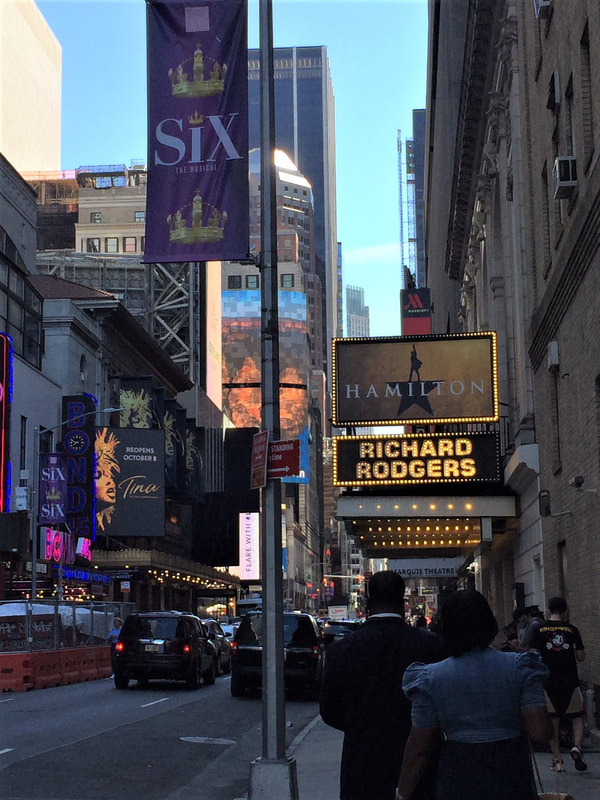|
By Laurie Lewis In honor of the reopening of Broadway theaters after a long dark spell, we look back on the history of theater in New York. West 46th Street off Broadway Opening dates for shows seen here: Hamilton, September 14; Six, September 17; Tina, October 8 As far back as colonial times, New York residents enjoyed theater. Then as now, theater often was a British import. The first documented performance by a professional troupe took place on December 6, 1732, when London actors staged the comedy The Recruiting Officer. The venue wasn’t actually a theater but an unused space near Maiden Lane and Pearl Street, at the time in the heart of New York City. Performances continued in makeshift spaces until 1750, when the Theater on Nassau Street became New York’s first permanent theater. It lasted only four years. In 1767, the John Street Theater opened around the corner from that site. It remained in business until 1798, when a 2,000-seat theater rose further north, opposite City Hall Park. Originally called the New Theatre, it later became the Park. Unlike the New York theater scene today, the eighteenth-century performances had no competition; each was the only game in town. During that period, the audience was mostly but not exclusively upper class. By the 1830s, entertainment choices in New York were expanding, with multiple venues, variety in the types of shows, and broader audiences. Shows at the Bowery Theatre, for example, appealed to a working-class clientele. By the mid-1860s, the Theater District had gravitated north along Broadway to 14th Street. By the 1870s, it had stretched another half-mile north to Madison Square. Then in 1880 came something brilliant, literally. The Brush Electric Light and Power Company installed powerful arc lamps along Broadway between 14th and 26th Streets. Before long, outdoor lights and new theaters appeared further north on Broadway, all the way to the 50s. The bright white lights gave the Theater District a nickname: The Great White Way. Later, electric light bulbs, which were softer and could add color to signage, followed by neon lights and more recently digital displays, created the spectacle that we associate today with the Theater District and Times Square. Times Square at night, 2013 The first theaters to open near Times Square (called Longacre Square until 1904) were the Casino (1882), the Metropolitan Opera House (1883), and the Broadway (1888). They were huge, elaborate performance spaces on Broadway between 39th and 41st Streets. By the turn of the century and especially after the subway started running in 1904, so many theaters were being built that they filled the side-streets in the 40s off Broadway, where many remain today. Just before the Depression, the Times Square area had seventy theaters. The Depression forced many of them to close or convert to movie houses or burlesque venues. Broadway enjoyed a revival in the 1940s and 1950s, thanks in large part to blockbuster musicals from Rodgers and Hammerstein (including South Pacific and The King and I) and Lerner and Loewe (such as Brigadoon and My Fair Lady). The city’s financial woes of the 1970s and 1980s led to deterioration of the Times Square area, but it bounced back in the 1990s. Forty-one Broadway theaters were operating when the pandemic forced the shutdown on March 12, 2020. They remained dark for well over a year. Then, in part to test COVID-19 protocols, a few big stars appeared in limited runs, starting with actor Nathan Lane and tap dancer Savion Glover in a brief, one-time performance in April. Bruce Springsteen reprised his one-man show in June. A new play, Pass Over, began previews in August. September has been the start of the full-fledged Broadway rival. Waitress and Hadestown returned on September 2. September 14 saw the reopening of four perennial favorites (Chicago, Hamilton, The Lion King, and Wicked) and the first preview of Lackawanna Blues. Six, which was supposed to debut the night that Broadway went dark, finally had its day on September 17. Many more shows are welcoming audiences this fall. Broadway is back! Posters for shows on Broadway this fall Opening dates for shows seen here: The Lion King, September 14; Come from Away, September 21; Diana, November 2 Tours Northern Central Park: Peak Fall Foliage
Take a walk with us in northern Central Park, and you’ll discover one of the best places for fall colors right in the heart of Manhattan. We’ll visit a tranquil spot to view the changing foliage, go on a short hike through the woods (on a paved path), and end at a formal garden bright with Korean chrysanthemums (they’re not your ordinary mums!). You’ll feel as if you’ve left the city and the stresses of the pandemic behind. We are offering this tour on three afternoons: Saturday, October 23; Wednesday, October 27; and Saturday, November 6. Email us at [email protected] with the date you want to take the tour, and we’ll reply with the starting time and meeting place. You must preregister at least 48 hours in advance. The tour costs $30 per person, but you will receive a discount if you bring a group of more than four people. The maximum number of people on any tour is 12. To see our other tour offerings and get ideas for a custom or private tour, visit our website www.takeawalknewyork.com. Comments are closed.
|
Archives
April 2024
|





